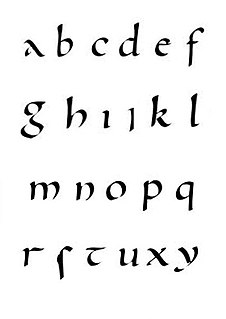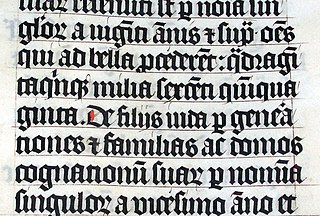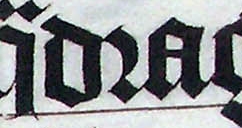
A, or a, is the first letter and the first vowel of the modern English alphabet and the ISO basic Latin alphabet. Its name in English is a, plural aes. It is similar in shape to the Ancient Greek letter alpha, from which it derives. The uppercase version consists of the two slanting sides of a triangle, crossed in the middle by a horizontal bar. The lowercase version can be written in two forms: the double-storey a and single-storey ɑ. The latter is commonly used in handwriting and fonts based on it, especially fonts intended to be read by children, and is also found in italic type.

The Latin alphabet or Roman alphabet is the collection of letters originally used by the ancient Romans to write the Latin language and its extensions used to write modern languages.

A manuscript was, traditionally, any document written by hand – or, once practical typewriters became available, typewritten – as opposed to mechanically printed or reproduced in some indirect or automated way. More recently, the term has come to be understood to further include any written, typed, or word-processed copy of an author's work, as distinguished from its rendition as a printed version of the same. Before the arrival of printing, all documents and books were manuscripts. Manuscripts are not defined by their contents, which may combine writing with mathematical calculations, maps, music notation, explanatory figures, or illustrations.

Palaeography (UK) or paleography is the study of historic writing systems and the deciphering and dating of historical manuscripts, including the analysis of historic handwriting. It is concerned with the forms and processes of writing; not the textual content of documents. Included in the discipline is the practice of deciphering, reading, and dating manuscripts, and the cultural context of writing, including the methods with which writing and books were produced, and the history of scriptoria.

R, or r, is the eighteenth letter of the modern English alphabet and the ISO basic Latin alphabet. Its name in English is ar, plural ars, or in Ireland or.

Penmanship is the technique of writing with the hand using a writing instrument. Today, this is most commonly done with a pen, or pencil, but throughout history has included many different implements. The various generic and formal historical styles of writing are called "hands" while an individual's style of penmanship is referred to as "handwriting".

Uncial is a majuscule script commonly used from the 4th to 8th centuries AD by Latin and Greek scribes. Uncial letters were used to write Greek and Latin, as well as Gothic and Coptic.

Carolingian minuscule or Caroline minuscule is a script which developed as a calligraphic standard in the medieval European period so that the Latin alphabet of Jerome's Vulgate Bible could be easily recognized by the literate class from one region to another. It is thought to have originated before AD 778 at the scriptorium of the Benedictine monks of Corbie Abbey, about 150 km (93 mi) north of Paris, and then developed by Alcuin of York for wide use in the Carolingian Renaissance. Alcuin himself still wrote in a script which was a precursor the Carolingian minuscule, which slowly developed over three centuries. He was most likely responsible for copying and preserving the manuscripts and upkeep of the script. It was used in the Holy Roman Empire between approximately 800 and 1200. Codices, pagan and Christian texts, and educational material were written in Carolingian minuscule.

Cursive is any style of penmanship in which characters are written joined in a flowing manner, generally for the purpose of making writing faster, in contrast to block letters. It varies in functionality and modern-day usage across languages and regions; being used both publicly in artistic and formal documents as well as in private communication. Formal cursive is generally joined, but casual cursive is a combination of joins and pen lifts. The writing style can be further divided as "looped", "italic" or "connected".

Blackletter, also known as Gothic script, Gothic minuscule, or Textura, was a script used throughout Western Europe from approximately 1150 until the 17th century. It continued to be commonly used for the Danish, Norwegian, and Swedish languages until the 1870s, and for the German language until the 1940s, when Hitler's distaste for the supposedly "Jewish-influenced" script saw it officially discontinued in 1941. Fraktur is a notable script of this type, and sometimes the entire group of blackletter faces is incorrectly referred to as Fraktur. Blackletter is sometimes referred to as Old English, but it is not to be confused with the Old English language, which predates blackletter by many centuries and was written in the insular script or in Futhorc. Along with Italic type and Roman type, blackletter served as one of the major typefaces in the history of Western typography.

Letter case is the distinction between the letters that are in larger uppercase or capitals and smaller lowercase in the written representation of certain languages. The writing systems that distinguish between the upper and lowercase have two parallel sets of letters, with each letter in one set usually having an equivalent in the other set. The two case variants are alternative representations of the same letter: they have the same name and pronunciation and are treated identically when sorting in alphabetical order.

The r rotunda ⟨ ꝛ ⟩, "rounded r", is a historical calligraphic variant of the minuscule (lowercase) letter Latin r used in full script-like typefaces, especially blackletters.

Roman cursive is a form of handwriting used in ancient Rome and to some extent into the Middle Ages. It is customarily divided into old cursive and new cursive.

Insular script was a medieval script system originating from Ireland that spread to Anglo-Saxon England and continental Europe under the influence of Irish Christianity. Irish missionaries took the script to continental Europe, where they founded monasteries such as Bobbio. The scripts were also used in monasteries like Fulda, which were influenced by English missionaries. They are associated with Insular art, of which most surviving examples are illuminated manuscripts. It greatly influenced Irish orthography and modern Gaelic scripts in handwriting and typefaces.

The Beneventan script was a medieval script which originated in the Duchy of Benevento in southern Italy. It was also called Langobarda, Longobarda, Longobardisca, or sometimes Gothica; it was first called Beneventan by palaeographer E. A. Lowe.

The history of the Greek alphabet starts with the adoption of Phoenician letter forms in the 9th–8th centuries BC during early Archaic Greece and continues to the present day. The Greek alphabet was developed during the Iron Age centuries after the loss of Linear B, the syllabic script that was used for writing Mycenaean Greek until the Late Bronze Age collapse and Greek Dark Age. This article concentrates on the development of the alphabet before the modern codification of the standard Greek alphabet.

The Latin script, also known as Roman script, is an alphabetic writing system based on the letters of the classical Latin alphabet, derived from a form of the Cumaean Greek version of the Greek alphabet used by the Etruscans. Several Latin-script alphabets exist, which differ in graphemes, collation and phonetic values from the classical Latin alphabet.

The Latin script is the most widely used alphabetic writing system in the world. It is the standard script of the English language and is often referred to simply as "the alphabet" in English. It is a true alphabet which originated in the 7th century BC in Italy and has changed continually over the last 2,500 years. It has roots in the Semitic alphabet and its offshoot alphabets, the Phoenician, Greek, and Etruscan. The phonetic values of some letters changed, some letters were lost and gained, and several writing styles ("hands") developed. Two such styles, the minuscule and majuscule hands, were combined into one script with alternate forms for the lower and upper case letters. Modern uppercase letters differ only slightly from their classical counterparts, and there are few regional variants.

The Armenian alphabet is an alphabetic writing system used to write Armenian. It was developed around 405 AD by Mesrop Mashtots, an Armenian linguist and ecclesiastical leader. The system originally had 36 letters; eventually, three more were adopted. The alphabet was also in wide use in the Ottoman Empire around the 18th and 19th centuries.

Greek minuscule was a Greek writing style which was developed as a book hand in Byzantine manuscripts during the 9th and 10th centuries. It replaced the earlier style of uncial writing, from which it differed in using smaller, more rounded and more connected letter forms, and in using many ligatures. Many of these forms had previously developed as parts of more informal cursive writing. The basic letter shapes used in the minuscule script are the ancestors of modern lower case Greek letters.

















